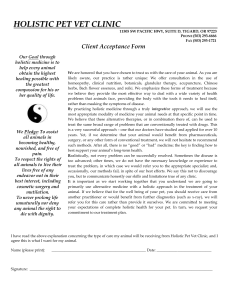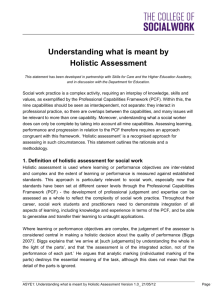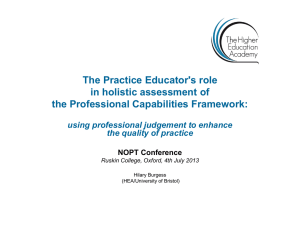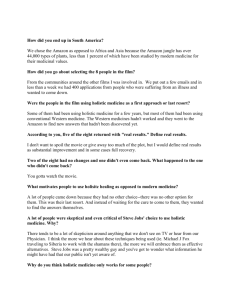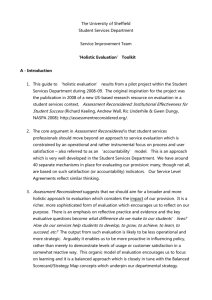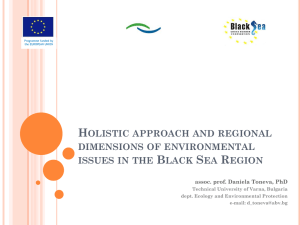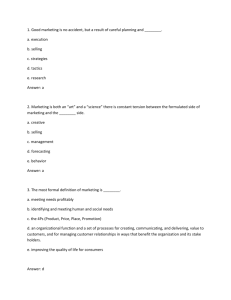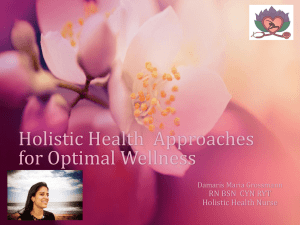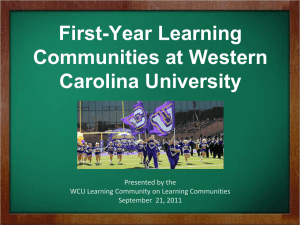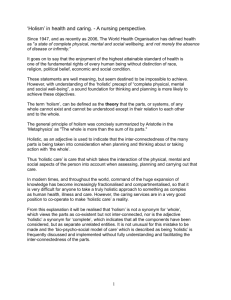NOPT holistic assessment - National Organisation for Practice
advertisement
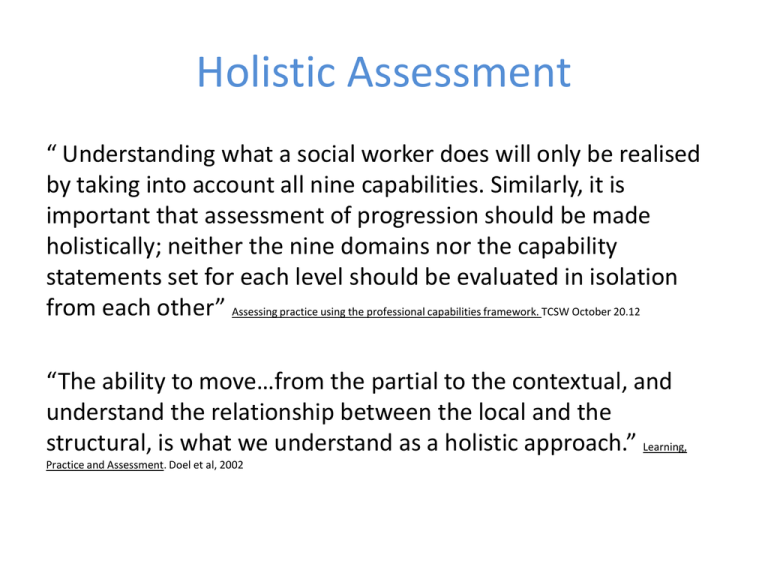
Holistic Assessment “ Understanding what a social worker does will only be realised by taking into account all nine capabilities. Similarly, it is important that assessment of progression should be made holistically; neither the nine domains nor the capability statements set for each level should be evaluated in isolation from each other” Assessing practice using the professional capabilities framework. TCSW October 20.12 “The ability to move…from the partial to the contextual, and understand the relationship between the local and the structural, is what we understand as a holistic approach.” Learning, Practice and Assessment. Doel et al, 2002 Partial and Contextual A holistic approach to assessment encompasses both partial and contextual approaches. • Partial – a detailed understanding of the various behavioural competences which constitute practice • Contextual – at a local level, an awareness of how practice is influenced by time and place; at a social level, an understanding of the structural influences on practice The law of the excluded middle • Dominant model of Western philosophical thinking – deriving from Descartes, 17th C. French philosopher • Cartesian ‘dualism’ – mind/body, good/evil, male/female, night/day • This dualism can be reframed as a continuum e.g. dawn and dusk between night and day • BUT – our understanding is also informed by the wider context – psychological, socio/economic/political Holistic assessment – guidelines from The College of Social Work (1) • Student progress should be considered as a journey - build on previous learning, identify future learning as part of their overall journey as professionals. Consider the information that you will need to support your student in their journey – how could you gather this? • Assessment should be on-going throughout the placement and linked to the PCF, resulting from the overall interaction between student and PE, as opposed to fixed episodes of assessment. How could you ensure that assessment is ongoing? Holistic assessment – guidelines from The College of Social Work (2) • Assessment should supported by evidence, not driven by it. A range of evidence linked to the PCF should be used – students will provide evidence but so will others. Who else might provide this evidence ? How will you evaluate this evidence and that of the student? • “Formal interim review” – called different things for different programmes. This process underpins the ongoing assessment and enables the PE to get support from the HEI to draw up an action plan. What should be addressed in the interim review? What should an action plan contain in order to support student progress? Placement Assessment report – TCSW suggested model Student evidence • • • • • 2 x Direct observations 2 x service user/carer feedback 3 x critical reflections 2 x extracts from supervision notes 2 x student work products – e.g. reports, assessments completed • 2 x other – e.g. a presentation Do you think this is sufficient? Are there other things that you would like to be included? Practice Educator’s report (1) An overall judgement of the student’s capability with reference to the level descriptors to include: • Capability across all nine domains of the PCF • Progressive assessment of the candidate’s capability during the placement • Any factors that may have affected the student’s progress during the placement Comments to be linked to examples of evidence. Student can add their own commentary. Assessment report (2) Holistic assessment of each domain • Assessment • Evidence used to support judgement • Capability demonstrated/not demonstrated N.B. This is guidance only from the College of Social Work and the Higher Education Academy – individual programmes may configure their assessment documents differently. Do you think that this suggested format meets your requirements of student assessment as a practice educator? Further Reading http://www.collegeofsocialwork.org/ http://www.skillsforcare.org.uk/socialwork/introductionsw.aspx • Biggs, J. (2007) Teaching for Quality Learning at University, Buckingham, SHRE and OU • Donnellan, H and Jack, G (2010) The Survival Guide for Newly Qualified Child and Family Social Workers. London. Jessica Kingsley • Galpin, D, Bigmore, J and Parker, J (2011). The Survival Guide for Newly Qualified Social Workers in Adult and Mental Health Services: Hitting the Ground Running . Jessica Kingsley • • • • • • • Knight, P. (2006) ‘The local practices of assessment’ in Assessment & Evaluation in Higher Education, 31. (4) pp. 435–452Doel, M., Nelson, P. and Flynn, E. (2008). Experiences of Post-qualifying Study in Social Work. Social Work Education, 27 (5), 549-571. Eraut, M. and Hirsh, W. (2007). The Significance of Workplace Learning for Individuals, Groups and Organisations. SKOPE. Oxford and Cardiff Universities/ESCR Centre on Skills, Knowledge and Organisational Performance. Cambridge University. Institute for Learning. Resources from across the Sector: http://www.ifl.ac.uk/cpd/cpd-guidance-andresources/cpd-resources Moriarty, J (2012). Social Work Post-qualifying courses 1990-2012. Messages about their Development and Impact. Kings College London and SCWRU Paulsson, K, Ivergard, T and Hunt, B. (2005) Learning at Work: Competence Development or Competence Stress. Applied Ergonomics 36. pp. 135-144. Elsevier. Skills for Care (2010)’ We Help to Develop Well Trained Care Staff. Skills for Care Skills for Care (2010). Keeping Up the Good Work. A Practical Guide to Implementing CPD in the Adult Social Care Workforce. The Higher Education Academy( 1998) The Concept of Capability and its Importance in Higher Education
